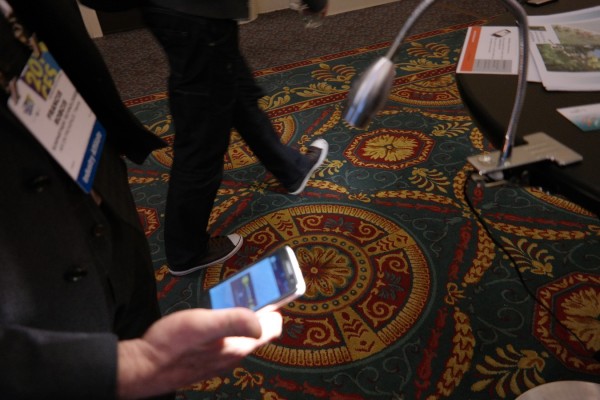Bright Idea: Smartphone Sensor Receives Data Via Light
Your next Internet hotspot could be a light bulb. For the past couple of years, various companies have worked on LiFi, a wireless networking standard that uses LED light to send data instead of radio waves. At CES 2014, French technology company Oledcomm showed off a device capable of transmitting data at broadband speeds using light from a lamp. And SunPartner Technologies unveiled Wysips Connect, a smartphone sensor that both downloads data and charges itself using those light rays. We had a chance to go hands-on with this technology and were amazed not only by its ability to send data using standard light bulbs, but its potential for indoor location services.
Using LiFi, buildings owners will soon be able to install overhead lights to track your location more precisely than before and to offer data feeds based on where you stand. In our brief demo, we took a phone with a Wysips Connect sensor and held it under a series of lamps. As we moved from one lamp to another an app on the device gave us walking directions based on our location. In a large indoor space, such as the Las Vegas Convention Center, LiFi would allow conventioneers to get step-by-step walking directions from one booth to another. In a retail environment, the store could give users product information or even coupons based on what light they're standing beneath.
MORE: Top 10 Smartphones
All of the lights we used in our hands-on were standard LED lamps like you could buy at any store. However, they had small LiFi boxes attached to their power cords. Though the process is imperceptible to the human eye, the boxes cause the lights to flicker at extremely high speeds. The smartphone sensor reads those flicker patterns and interprets them as data. A Wysips representative said that the current prototype is only capable of receiving LiFi data at a rate of 24 Kbps, but he expects future versions of the prototype to reach speeds as high 1 Mbps. Even so, if you're only getting small pieces of data like location coordinates, 24 Kbps is more than enough. Like prior-generation Wysips sesnors, the Connect can also use the light for charging.
In another area of the booth, we used a Macbook laptop that was hooked up to an Oledcomm LiFi receiver beneath a lamp connected to standard router. When surfed the Web on the laptop, Web pages and streaming video loaded flawlessly with a maximum transfer rate of 10Mbps; close to the speeds of many home ISPs, which range from 10 to 20 Mbps. In this set up, the light was only going one way so, in order for the laptop to send commands such as URL requests back to the router, the LiFi receiver also had an infrared port that sent those commands back to a sensor in the lamp. An Oldecomm rep said that, in future LiFi networks, devices may also have their own LED bulbs for uploading.
MORE: Meta Pro AR Goggles Kick Google's Glass
While LiFi is unlikely to replace Wi-Fi, 4G and other radio-wave connections, it seems like there's a bright future for light-based networking. Not only can LiFi-enabled lights transmit very precise indoor location data, but they also offer a level of physical security you won't find in other wireless solutions. If you have to be under the light to get the data, a hacker sitting several feet away, presumably, won't have access. And though Oledcomm's best demo only reaches 10 Mbps, a team of British researches recently achieved speeds of 10 Gbps using LiFi in the lab.
Sign up to receive The Snapshot, a free special dispatch from Laptop Mag, in your inbox.
We've been tracking SunPartner's' Wysips solar power sensors for a few years now and have been disappointed that they haven't yet appeared in any smartphones. However, with the addition of LiFi connectivity, the solar charging capability becomes a secondary benefit and the entire sensor becomes more compelling for OEMs. Sending data via light is the future and Wysips Connect breaks new ground by bringing that technology to phones. Whether it's Wysips or another product, LiFi has a bright future.






